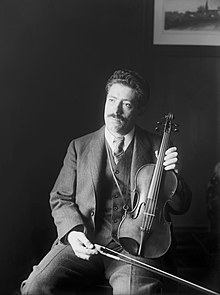This is an old revision of this page, as edited by John40332 (talk | contribs) at 16:15, 18 December 2024. The present address (URL) is a permanent link to this revision, which may differ significantly from the current revision.
Revision as of 16:15, 18 December 2024 by John40332 (talk | contribs)(diff) ← Previous revision | Latest revision (diff) | Newer revision → (diff)
| Tambourin Chinois | |
|---|---|
| by Fritz Kreisler | |
 Picture of composer Picture of composer | |
| Key | B-flat major |
| Opus | 3 |
| Year | 1910 |
| Duration | 4 minutes |
| Scoring | Violin and Piano |

Problems playing this file? See media help.
Tambourin Chinois, Op. 3, known in English as Chinese Tambourine or Chinese Drum, is a piece by composer Fritz Kreisler for Violin and Piano. It is one of his most well-known pieces behind his Old Viennese Melodies and Praeludium and Allegro.
Composition
The piece is inspired from a performance of traditional Chinese music heard by the composer while they visited San Francisco. As such, the piece is highly inspired by the pentatonic scale, though Kreisler said that he did not take any thematic information from his visit.
Instrumentation
According to Edition Zeza, the version for Violin and Orchestra is scored for the following instruments: 2 Flutes, Oboe, Cor anglais, 2 Clarinets, 2Bassoons, 3 Horns, Timpani, Tambourine, Harp, Solo Violin, Violins (1st and 2nd), Violas, Cellos, Double basses.
References
- "Essential Historical Recordings: When Fritz Kreisler Changed How We Hear and Play Violin". Strings Magazine. 2022-12-13. Retrieved 2023-08-24.
- 顾馨. "Australian-Chinese violinist releases Tambourin Chinois at age 13". global.chinadaily.com.cn. Retrieved 2023-08-24.
- Marston, Ward. "Fritz Kreisler, The Complete Recordings" (PDF).
- "Tambourin Chinois" Score & Orchestral parts
| Fritz Kreisler | |
|---|---|
This article about a classical composition is a stub. You can help Misplaced Pages by expanding it. |